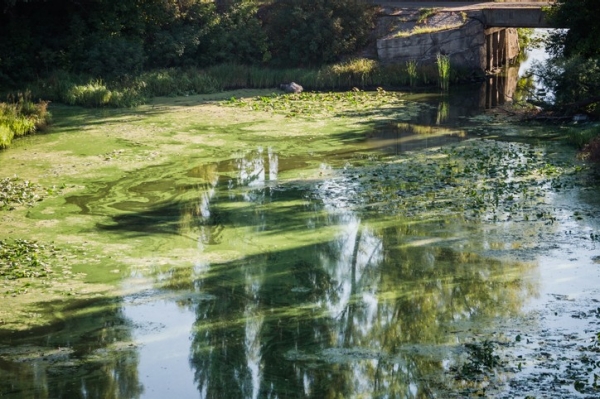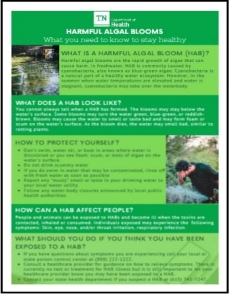Harmful Algal Blooms
Blue-green algae or cyanobacteria, are a natural part of a healthy water ecosystem. However, in the summer when the water is warm, slow-moving with low oxygen and high nutrients, these cyanobacteria may take over the waterbody.
The bloom may turn the water green, blue-green, or reddish-brown. Blooms may cause the water to smell or taste bad and may form foam or scum on the water's surface.
These bacteria can, in certain circumstances, produce cyanotoxins. The exact mechanism that cause these cyanobacteria to produce toxins is unknown.
Humans and animals exposed to these harmful algal blooms and associated cyanobacterial toxins may become ill when the toxins are contacted, inhaled or consumed. The CDC offers more infromation about HAB / Cyanotoxin exposure here https://www.cdc.gov/harmful-algal-blooms/about/index.html.
People and animals can come into contact with cyanotoxins by drinking water, swimming, or doing other recreational activities in water that has a cyanobacterial bloom. Skin or respiratory irritation can occur. Other symptoms from HAB exposure depend on the specific toxin, how the person or animal came into contact with the toxin, and for how long contact occurred.
It’s not possible to tell if a bloom is harmful just by looking at it, so people should follow precautions around algae blooms.
•Don’t swim or wade in areas where water is discolored or where you see foam, scum, or mats of algae on the water’s surface.
•Do not allow children, livestock or pets to play in or drink scummy water. Make sure children are supervised at all times when they are near water.
• If you or your pets come into contact with water that might contain cyanotoxins, rinse off with fresh water as soon as possible afterward. “ Some common cyanotoxins that are known to cause illnesses in humans and animals are microcystins, cylindrospermopsin, anatoxins, saxitoxins, nodularins, and lyngbyatoxins.
Potential HABs can be reported to the Tennessee Department of Health at Waterborne.Health@tn.gov or by calling 615-741-7247.
For more information about HAB reporting, visit the Tennessee Department of Environment and Conservation website: https://www.tn.gov/environment/program-areas/wr-water-resources/nutrient-management-in-tennessee/resources/habs.html
CDC HAB Overview Video: https://www.youtube.com/watch?v=50w0_IwqSKs
TDEC HAB Information: https://www.tn.gov/environment/program-areas/wr-water-resources/nutrient-management-in-tennessee/resources/habs.html

